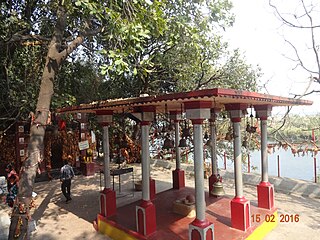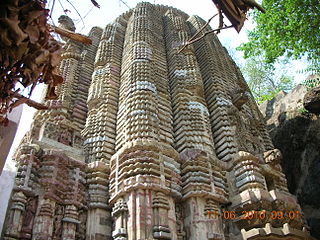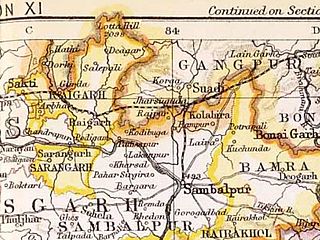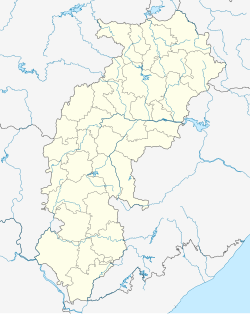
Sakti is a city and a district in the state of Chhattisgarh. The assembly constituency number of District Sakti is 33, Earlier it was the only Education District of Chhattisgarh. There are 245 panchayats and 458 villages under Sakti district. Sakti district was formed on 15 August 2021 And came into complete district existence on 9 September 2022 by Chief Minister Bhupesh Baghel. The current 2018 - 2023 MLA here is Shri Charan Das Mahant, who is the Speaker of the Chhattisgarh Legislative assembly. The First Collector and District Magistrate of Sakti is Nupur Rashi Panna I.A.S, First Superintendent of Police is M.R. Ahire I.P.S and First District Education Officer is B.L. Khare, who was also the last District Education Officer of Education District Sakti.
Rajnandgaon is a city in Rajnandgaon District, in the state of Chhattisgarh, India. As of the 2011 census the population of the city was 163,122. Rajnandgaon district came into existence on 26 January 1973, as a result of the division of Durg district.

Raigarh district is a district of the central Indian state of Chhattisgarh. Raigarh is the district headquarters.

Sambalpur District is a district in the western part of state of Odisha, India. The historic city of Sambalpur is the district headquarters.

Raigarh is a city in northern Chhattisgarh known as the 'Cultural capital of Chhattisgarh'; Raigarh is famous for its dance form “Kathak” and classical music; Raigarh is also known as Sanskardhani.

Bargarh District is an administrative district of Odisha state in eastern India. The city of Bargarh is its district headquarters. The district was carved out of the erstwhile district of Sambalpur on 1 April 1993.

Kawardha is a town and a municipality in Kabirdham district in the Indian state of Chhattisgarh. It is the administrative headquarters of Kabirdham district. Kawardha is also known for the "Temple of Bhoramdeo."

Mahasamund district is a district in Chhattisgarh state in central India. The city of Mahasamund is the district headquarters. The district is particularly famous for the historical temple town of Sirpur besides the Mahanadi river.
Raja Nareshchandra Singh, was ruler of Sarangarh state in Raigarh District, Chhattisgarh. He also served as Chief Minister of undivided Madhya Pradesh.
Sarangarh was a Lok Sabha (parliamentary) constituency in Chhattisgarh state in central India. It was dissolved in 2009.
Pushpa Devi Singh is an Indian politician who served on the 7th Lok Sabha for the Indian National Congress party.

Sakti State was one of the princely states of India during the British Raj. It belonged to the Chhattisgarh States Agency, which later became the Eastern States Agency.

Raigarh was a princely state in India at the time of the British Raj. The state was ruled by a Gond dynasty of Gond clan.

Udaipur State was one of the princely states of India during the period of the British Raj. The town of Dharamjaigarh was the former state's capital.

Kawardha State was one of the princely states in the Central Provinces of India during the period of the British Raj. The capital of the state was Khairagarh town, in Kabirdham district of Chhattisgarh state. The Bhoramdeo Temple is located less than 20 km to the west of the main town.

Sarangarh was a princely state in India during the British Raj ruled by a Raj Gond dynasty. The emblem of the state was a turtle.

Sambalpur State, also known as Hirakhand Kingdom was a kingdom founded in 1570. It ruled over Western Odisha and Eastern Chhattisgarh in central-eastern India prior to the Maratha occupation in 1800 AD. From 1849 AD it was integrated with British Raj as a British District. Its capital was present-day Sambalpur city in Western Odisha.

Jashpur State was one of the princely states of India during the period of the British Raj. The town of Jashpur was the former state's capital. The rulers were Rajputs of Chauhan Clan.

Kanker State was one of the princely states of India during the period of the British Raj. Its last ruler signed the accession to the Indian Union in 1947.
Paras Ram Bhardwaj was an Indian politician and a member of the 12th Lok Sabha representing Sarangarh of Madhya Pradesh State till 2000 and from Chhattisgarh State later.
















